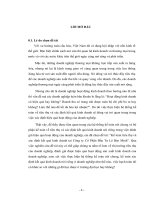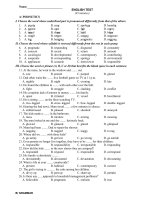Chemistryofcombustion min
Bạn đang xem bản rút gọn của tài liệu. Xem và tải ngay bản đầy đủ của tài liệu tại đây (1.11 MB, 47 trang )
chemistry of fire
1
fire
Definition
It is a chemical chain
reaction which takes place
with the evolution of heat and
light.
2
Fire triangle
3
Essentials of Fire
Fuel
FIRE
Heat
Oxygen
4
OXYGEN SOURCE
HEAT SOURCES
To Reach Ignition Temp.
Approx. 16% Required
Normal air contains 21% of oxygen
Some Fuels contains its own oxygen
supply
Oxygen
Open Flame, the Sun,Hot Surface,
Sparks & Arcs, Friction, Chemical
Action, Elec. Energy & Gas
Compression
Heat
Fuel
GASES
Natural Gas,
Propane, CO,
Butane, Hydrogen,
Acetylene,
LIQUIDS
Gasoline, Kerosene,
Turpentine, Alcohol,
Paint, Varnish, Olive
oil, Lacquer
FIRE TRIANGLE
SOLIDS
Coal, Wood, Paper,
Cloth, Wax, Grease,
Leather, Plastic,
Sugar, Grain, Hay,
5
Fire Tetrahedron
6
Principles of Fire Extinction
1. Starvation
Removal of un-burnt material from fire area
7
Principles of Fire Extinction
2. Smothering
Cutting off the supply of oxygen from fire area
8
Principles of Fire Extinction
3. Cooling
Removal of heat from the burning material/fire
area
9
Principles of Fire Extinction
4. Breaking of chain reaction
It is a chemical process
Mono-ammonium phosphate
NH3
&
H2O
Ortho-Phosphoric Acid
Meta-Phosphoric Acid
Flame
Steam
10
Fig: Extinguishing mechanism of multipurpose mono-ammonium phosphate dry chemical
Phases of Burning
It depends on the following
factors
i. The amount of time the fire has burnt.
ii. The ventilation characteristics of the
confining structure
iii. The amount and type of combustibles
present.
11
Three progressives stages of
burning
•Incipient or beginning phase
•Free burning phase
•Smoldering phase
12
Oxygen Rich
Atmosphere
Oxygen Deficient
Atmosphere
13
Incipient or beginning
phase
•Oxygen plentiful
•Temperature has not built
up
to high peak
•Thermal updraft rises,
accumulates at highest
point
•Breathing not difficult
•Fire extinguishments :
–Direct application of water
at base of fire.
•Ventilation :not a problem
14
•Little steam production
Free burning phase
•Fire has involved more fuel
•Oxygen supply is being
depleted
• Heat accumulated at upper
areas
•Breathing difficult : Masks
recommended
•Fire extinguishments is
reaching
the area of major
involvement
•Ventilation : Not a definite
15
need
Smoldering phase
•Oxygen supply not equal
to
demands of fire
•Temperature throughout
building is
very high
• Normal breathing is not
possible
•Oxygen deficiency may
cause
back-draft
•Fire extinguishments
indirect
method
•Ventilation : A must
•Maximum steam
16
production from water
Smoldering
phase
17
Modes of spread of
Conduction fire
It occurs only in solids i.e.
metallic objects.
Convection
It occurs both in liquids &
gases
Radiation
It is neither conduction nor
convection. These are heated
rays emanating from the hot
object.
18
Conduction •Heat energy is
Highly Excited
Less Agitated
passed on
from one molecule to
the
next
•The molecule vibrates
above its mean
position
•Pass on heat energy
by
colliding with their
19
neighbors
Conduction
20
conduction
21
Convectio
n
• When a liquid or gas
heated,
it expands
•
It becomes less dense
•
The lighter fluid arises
being
displaced by colder and
therefore denser fluid
•
In turn becomes
heated and
so a circulation is set
up
•
22
Heat energy is carried
Fig: Fire Plume
23
Radiation
• It does not
involved
any contact
between
bodies
•
It is independent
of
any material in
the
intervening space
• These are the
heated
rays, travels in24
Other chemical reactions which
produce
1. Combustion (heat & light)
2. Combustion (without heat & light)
3. Combustion ( without heat)
25









